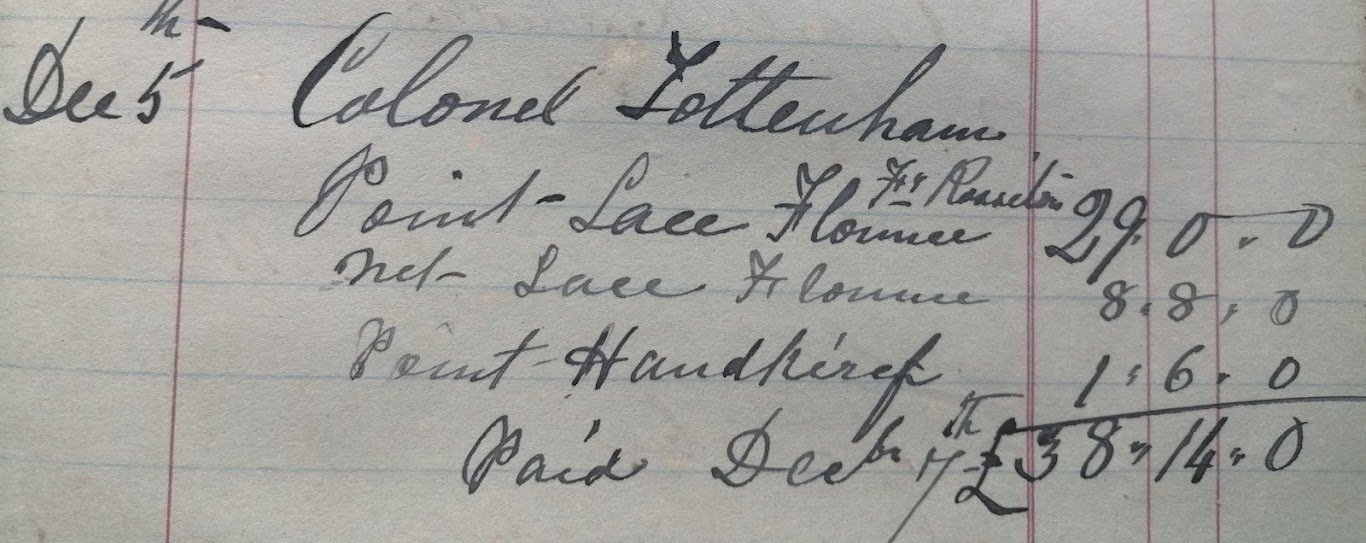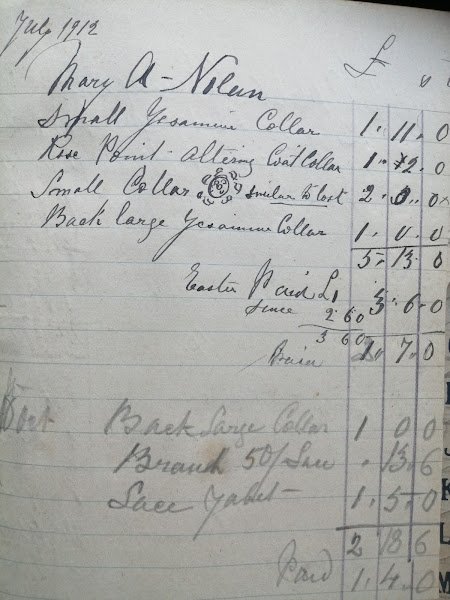LACE ACCOUNTS 1875-1914
The Mount Carmel Collection includes two account books relating to lace-making, which are very significant in terms of historical archives.
The social history contained in them is fascinating, such as the money earned by the lace workers and the buyers to whom lace was being sent.
It is very interesting to see the amount of material sent to the Royal Jubilee Exhibition in Manchester in 1887. Similarly to read of the various outlets like the Irish Warehouse in Regent Street in London
One of the greatest difficulties facing Mount Carmel Industrial Lace School was to secure a regular market, private orders being irregular and uncertain.
In this regard, the various Exhibitions in London and Dublin, the Shows at Ballsbridge, and the efforts of the Irish Industries Association, the Board of National Education, the Department of Education, and the Department of Industry were invaluable. They provided a stimulus and the necessary publicity for bringing the centres into touch with a more regular market through the big lace houses etc.
A Frenchman, Monsiour L.J. Maree began purchasing significant amounts of Mount Carmel Lace for the French market in January 1875 and continued to his death in 1899.
After his death, his only sister sold his establishment to his clerk who formed a new company: Mess Fiques Guyomet Suppliux. Frequently sales to France were recorded simply as “Frenchman”!
An illustration of the importance of the “Frenchman” in the trade of Mount Carmel Lace is that in 1878 Monsieur Maree purchased £868-13-6 out of total sales for that year of £ 1086-6-10 ( 80% of the annual sales). In 1880, Mr. Maree purchased 61% of the total sales.
Another significant category of purchaser was described as “ Ladies in general for business and Private Purposes”. In 1878, they purchased £178-4-10, representing 16% of total sales. In 1880 their share increased to 22%.
Some of the other Lace Agents mentioned include:
Mr. Walter G. Holland at the Irish Warehouse in London
Mr. Cooke at the Hibernian Lace Company
Mr. James Crosbie in Belfast
Miss Margaret Browne in Buenos Aires.
Slattery Boston Firm
London Depot
Dublin Depot
The Sales Book records details of countless individuals who made direct contact with their requirements. Many are from religious houses for lace vestments and altar falls. Others are from ordinary individuals purchasing items for personal use such as handkerchiefs, collars, or tableware. In the middle of all of this detail, it is quite amazing to find an order from the Empress of Austria! Our hope for the future is to scan the contents of the Lace Account 1875-1914 to permit general access and to present a more in-depth analysis of the contents.
The following are among the described items recorded in the Sales Book:
Deep Diamond Tatting
Doyleys
Ecrue Coarse Star
Edging
Fine Adrieu
Fine Caps
Fine Lace
Greek Crochet Lace
Greek Lace Insertion
Adrien Sabina
Black Rose Point
Buttonholes
Chemise Trimmings
Coarse Caps
Coarse Shell Pattern
Collars
Crochet
Curtains Coarse Sabina
Guipure Chemise Trimmings
Guipure Lace
Hibernian Lace
Jasmine
Milward Lace
Narrow Mitre
Peacock Guipure
Pillow Covers
Passionflower Lace
Point Lace
Rochet
Rose Point
Sabina Insertion
Shamrock Edging
Sophia Lace
Wheel Pointed
Wicklow
Youghal
Wages Book
The real value of Mount Carmel Lace was in the dramatic rise in Living Standards it afforded to local families who benefited from the income earned.
An entry for the 1907 Wages Book shows that the average wage earned per week was between 10 and 15 shillings per week- averaging £ 32 per annum. It is difficult for modern-day readers to put a practical value on such earnings. It might help to compare with the earnings of local men around this time. A contemporary local source recorded the daily wages paid to men building the Parish Church of New Ross which was completed in 1902. The daily pay rates were 5 shillings and 6 pence for masons ( 33 shillings per week), 5 shillings for carpenters ( 30 shillings per week), and 2 shillings and 4 pence for labourers ( 14 shillings per week). Hence, the economic benefits to local families afforded by the employment of many local women and girls were enormous.
The Carmelite Nuns succeeded admirably in fulfilling the founding intention for the Lace School.
To this day, local people remember with gratitude the opportunities that were afforded to previous generations by the enterprising and selfless Nuns.















